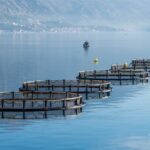Sustainable aquaculture, the practice of farming aquatic organisms in a way that minimizes environmental impact while maximizing production, holds significant promise for benefiting ecosystems worldwide. As concerns about overfishing, habitat destruction, and environmental degradation continue to mount, sustainable aquaculture emerges as a vital solution to help alleviate pressure on wild fish populations and ecosystems. This article explores how sustainable aquaculture practices contribute to the health and balance of ecosystems.
Preserving Wild Fish Populations
One of the primary ways sustainable aquaculture benefits ecosystems is by reducing the strain on wild fish populations. Overfishing has led to declines in numerous fish species, disrupting food chains and endangering marine biodiversity. By cultivating fish through sustainable aquaculture methods, the demand for wild-caught fish decreases, allowing populations to recover and maintain their ecological roles within their respective ecosystems.
Minimizing Habitat Destruction
Traditional fishing methods, such as bottom trawling, can cause significant damage to marine habitats, including coral reefs, seagrass beds, and ocean floors. Sustainable aquaculture operations, however, are often conducted in controlled environments such as ponds, tanks, or offshore cages, minimizing habitat destruction. By confining farming activities to designated areas, the impact on natural ecosystems is significantly reduced, preserving essential habitats for countless marine species.
Reducing Pollution
Aquaculture has the potential to generate pollution through the release of excess feed, waste, and antibiotics into surrounding waters. However, sustainable aquaculture practices focus on minimizing environmental impact by implementing efficient feeding techniques, wastewater treatment systems, and disease prevention measures. Through careful management and adherence to best practices, sustainable aquaculture operations can significantly reduce pollution levels, safeguarding water quality and ecosystem health.
Promoting Biodiversity
Contrary to conventional belief, sustainable aquaculture can actually promote biodiversity when implemented correctly. By cultivating a diverse range of species, including fish, mollusks, and seaweeds, aquaculture facilities can mimic natural ecosystems and create opportunities for symbiotic relationships to flourish. Additionally, integrating aquaculture with other forms of marine conservation, such as mangrove restoration and marine protected areas, further enhances biodiversity and strengthens ecosystem resilience.
Enhancing Food Security
Sustainable aquaculture plays a crucial role in enhancing food security by providing a reliable source of nutritious protein for communities around the world. As global demand for seafood continues to rise, traditional fishing methods alone are unable to meet the needs of a growing population. By supplementing wild-caught fish with sustainably farmed alternatives, aquaculture helps alleviate pressure on overexploited fisheries while ensuring a steady supply of food for present and future generations.
Supporting Coastal Communities
In addition to its ecological benefits, sustainable aquaculture also contributes to the socioeconomic well-being of coastal communities. By creating employment opportunities, stimulating economic growth, and empowering local stakeholders, aquaculture helps alleviate poverty and improve livelihoods in regions where traditional fishing may no longer be sustainable. Moreover, by fostering a sense of stewardship and responsibility towards marine resources, sustainable aquaculture encourages community engagement in conservation efforts, further strengthening ecosystem protection.
Conclusion
In conclusion, sustainable aquaculture offers a range of benefits for ecosystems worldwide. By preserving wild fish populations, minimizing habitat destruction, reducing pollution, promoting biodiversity, enhancing food security, and supporting coastal communities, aquaculture emerges as a valuable tool for achieving sustainable development goals. As we continue to address the challenges of feeding a growing population while preserving the health of our planet, investing in sustainable aquaculture practices becomes increasingly imperative. Through collaborative efforts between governments, industry stakeholders, and local communities, we can harness the potential of aquaculture to create a more resilient and ecologically balanced future for generations to come.
Click here for more info: Save The Penguins

